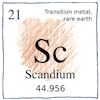Uppsala—Lars Fredrik Nilson
elements

|
Scandium
Lars Fredrik Nilson, a student of Berzelius, did a spectral analysis of gadolinite and euxenite and found a new element that he was able to separate from the ytterbia of Marignac.
Atomic number 21
Some metal-halide light bulbs use iodine, sodium, and scandium. Some dentists use erbium, chromium: yttrium-scandium-gallium garnet lasers (a mouthful). Some aluminum alloys have a fraction of a percent of scandium, which by itself is a soft metal, but which hardens and strengthens the aluminum.
Lewis acids
Scandium halides are Lewis acids and scandium triflate is a Lewis acid catalyst. Here begins a lesson in organic chemistry in which you learn that the chemical reaction between a Lewis acid and a Lewis base results in the combination of the two, the Lewis adduct, sharing a pair of electrons donated to the adduct by the Lewis base. The power of organoscandium chemistry is in coordination numbers between six and twelve, which we learn means that scandium compounds can form ionic bonds with many other atoms at a time, nothing to do with astrological favorability. These lively little guys swing with polymers.



Dmitri Mendeleev had predicted an element with the chemical properties of scandium, and had called it ekaboron. Lars Fredrik Nilson named it scandium after the Latin name for Scandinavia.
See also in The book of science:
Readings in wikipedia:
Other readings: